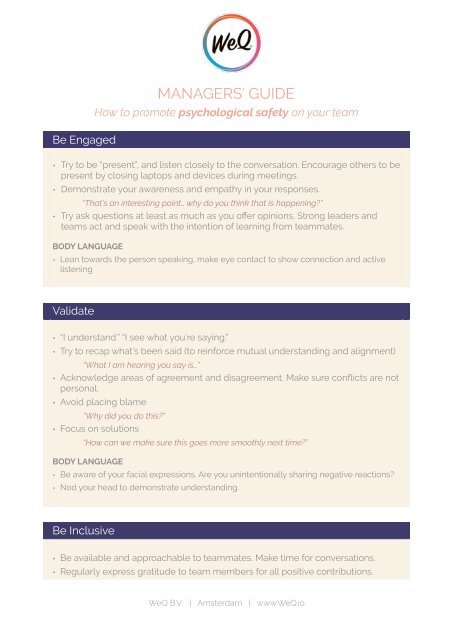Mangers'guide_PsychologicalSafety.2
You also want an ePaper? Increase the reach of your titles
YUMPU automatically turns print PDFs into web optimized ePapers that Google loves.
Be Engaged<br />
MANAGERS’ GUIDE<br />
How to promote psychological safety on your team<br />
• Try to be “present”, and listen closely to the conversation. Encourage others to be<br />
present by closing laptops and devices during meetings.<br />
• Demonstrate your awareness and empathy in your responses.<br />
“That’s an interesting point… why do you think that is happening?”<br />
• Try ask questions at least as much as you offer opinions. Strong leaders and<br />
teams act and speak with the intention of learning from teammates.<br />
BODY LANGUAGE<br />
• Lean towards the person speaking, make eye contact to show connection and active<br />
listening<br />
Validate<br />
• “I understand.” “I see what you’re saying.”<br />
• Try to recap what’s been said (to reinforce mutual understanding and alignment)<br />
“What I am hearing you say is…”<br />
• Acknowledge areas of agreement and disagreement. Make sure conflicts are not<br />
personal.<br />
• Avoid placing blame<br />
“Why did you do this?”<br />
• Focus on solutions<br />
“How can we make sure this goes more smoothly next time?”<br />
BODY LANGUAGE<br />
• Be aware of your facial expressions. Are you unintentionally sharing negative reactions?<br />
• Nod your head to demonstrate understanding.<br />
Be Inclusive<br />
• Be available and approachable to teammates. Make time for conversations.<br />
• Regularly express gratitude to team members for all positive contributions.<br />
WeQ B.V. | Amsterdam | www.WeQ.io
• Share information about your personal work style and preferences. Encourage<br />
teammates to do the same.<br />
• Talk with teammates about their lives outside of work.<br />
• Clearly communicate the purpose of all meetings.<br />
• Don’t let team members talk negatively about other team members.<br />
BODY LANGUAGE<br />
• Open body posture.<br />
• Face all team members, don’t turn your back to members of the group.<br />
Share Decision-Making<br />
• Encourage questions<br />
• Ask for input, opinions, and feedback from your teammates.<br />
• Try not to interrupt others. Help others to step in when someone is interrupted<br />
and ensure his/her idea is heard.<br />
• Explain the reasoning behind your decisions.<br />
• Be sure to share when a team member contributes to a decision or a success.<br />
Be Confident, But Not Inflexible<br />
• Encourage the team to challenge you. But stick to your convictions and<br />
principles, and defend your view if you are not persuaded.<br />
• Manage team discussions. Prevent off-topic conversations during meetings.<br />
• Encourage teammates to take risks, and demonstrate risk-taking in your own<br />
work.<br />
• Don’t be afraid to show vulnerability; share failures and concerns with your<br />
teammates.<br />
Additional resources<br />
• High-Performing team needs psychological safety. Here is how to create it. L. Delizonna Harvard<br />
Business Review, 2017<br />
• Edmondson and Lei (2014). "Psychological Safety: The History, Renaissance, and Future of an<br />
Interpersonal Construct," Annual Review Organizational Psychology and Organizational Behavior.<br />
• Teaming: How Organizations Learn, Innovate, and Compete in the Knowledge Economy. A.<br />
Edmonson<br />
WeQ B.V. | Amsterdam | www.WeQ.io


